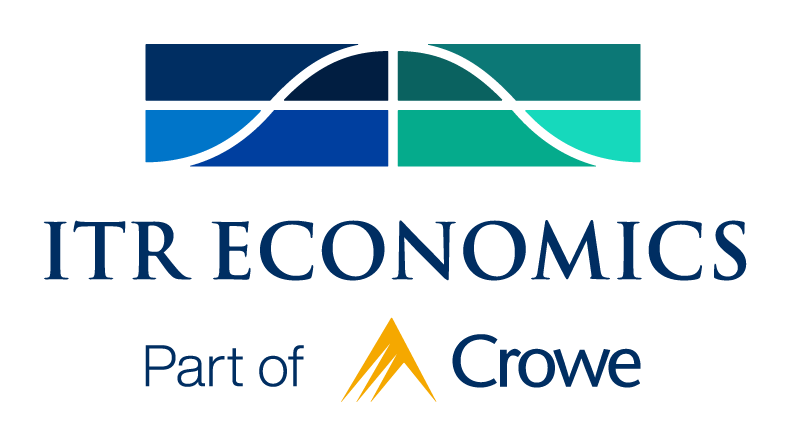August 19, 2024
- Home
- portfolio
- TrendsTalk
- August 19, 2024
ECONOMIC IMPACT OF PROPOSED TARIFF POLICIES
The Biden administration recently made some announcements regarding changes to tariffs. What does this mean from an apolitical, economic standpoint? Catch our unbiased perspective this week on TrendsTalk with ITR Economist Taylor St. Germain!

MEET YOUR HOST
Taylor St. Germain
As an experienced economist, Taylor St. Germain provides consulting services for small businesses, trade associations, and Fortune 500 companies across a spectrum of industries. His dynamic personality and extensive knowledge of economic trends and their business relevance are highly valued by clients and colleagues alike.
“Join me on the TrendsTalk podcast to explore the world of economics. Episodes offer insightful discussion and expert interviews. We cover relevant economic concepts in an accessible way. Whether you are a curious layperson or an industry professional, TrendsTalk is your go-to source for thought-provoking analysis and a deeper understanding of the economic forces shaping our world.”
The below transcript is a literal translation of the podcast audio that has been machine generated by Notta.
Hi everyone, my name is Taylor St. Germain with ITR Economics, and welcome to this edition of TrendTalk. We at ITR are your apolitical and unbiased source of economic intelligence, and we’re going to stay apolitical today, but I wanted to discuss tariffs.
I wanted to discuss some of the announcements that have been made from the Biden administration, and a lot of this information I’m getting directly off whitehouse.gov. And so this is coming right from the White House press briefing, and I wanted to highlight some of the proposed changes under the Biden administration. He’s made it very clear he’s trying to eliminate China’s unfair trade practices.
Now things can certainly change depending on the outcome of the election this year. However, it’s pretty clear to us that both parties are interested in furthering the, or I should say increasing the rate of tariffs. Of course, President Trump previously implemented tariffs. We’ve seen tariffs implemented by most administrations over the last few decades, going all the way back to George W. Bush.
So I wanted to just give an update on some of the tariff implementation we’ve seen, and then talk a little bit about our perspective on what we’re seeing for the pricing environment as we move further into this 2024, but certainly into 2025. So directly from, again, the White House, the tariff rate on certain Steel and Aluminum products under section 301 will increase from 0-7.5% to 25% in 2024. We’re also seeing a tariff rate on Semiconductors that will increase from 25% to 50% by 2025.
The tariff rate on Electric Vehicles under section 301 will also increase from 25% to 100% in 2024. And we’re also seeing batteries, Battery Components and Critical Minerals targeted. So if you look at the tariff rate on lithium ion EV batteries that will increase from 7.5% to 25% in 2024, while the tariff rate on lithium ion non-EV batteries will also increase from 7.5% to 25% in 2026. And then the tariff rate on battery parts will increase from 7.5% to 25% in 2024. Solar Cells are being targeted with the tariff rate increasing from 25 to 50% in 2024. We’re also seeing medical products in Ship-to-Shore Cranes, seeing tariff rate increases. So Ship-to-Shore Cranes will increase from 0-25% in 2024, and then medical products, specifically the tariff rates on syringes and needles will increase from 0% to 50% in 2024. And again, you can find this briefing on whitehouse.gov. It was issued at the end of May.
So overall, you’re seeing that the current administration is targeting a lot of these industries, really focusing though on Steel, Aluminum, Medical Products, Semiconductors and the EV market. Those are the very notable ones here. Now, there is one perspective, which is to discourage China’s trade practices. Although I think we’ve seen in the past that there’s creative ways that China can get around tariffs by circumventing through other countries. And even though the administrations of the past, whether it’s been Democrats or Republicans have said, they’ve cracked down on some of the skirting the US tariffs through different countries, it’s pretty clear that things are still making their way in.
But overall, it’s very clear that this US first perspective is going to continue to make up a bigger part of our lives as we move forward. Now, again, there’s some people that really love tariffs. If you’re a steel producer here in the US or aluminum producer, and you have the capacity to take on more demand, maybe you’re in favor of tariffs. So I don’t want to discount both sides of the story here, but we’ve learned from 2018, there’s another side to the story and that’s significant inflation that can result from these tariffs. Somebody has to pay for these tariffs. And unfortunately, it’s often the US consumer that ends up bearing the brunt of these tariffs as businesses raise their prices to deal with these higher input costs, the cost of their higher inputs and those costs get passed along.
And so it’s often the US consumer that ends up bearing the brunt of quite a few of these tariffs. Now, again, two sides to the story is always, there’s always winners and losers, but it’s important that we’re understanding that this more nationalistic America first, while good sounding certainly has repercussions when we look down the line.
Now, the reason I bring up all of these tariffs is because from our perspective, producers should already be preparing for a higher price environment as we look at ’25 and ’26 in particular, and you’ll start to feel some of that lift in the second half of this year. For those Trends Report subscribers, you can go look at our Producer Price Index. And what you’ll notice is that the 1/12 growth rate, the month-over-month growth rate has bottomed off a low and is rising above zero. And when you look at our forecast for the annual growth rate, you’ll see 1% for ’24, 2.6% for ’25, and 3.4% for ’26. So when I say Producer Price Index, that’s average selling prices of Finished Goods and Services. And with those annual growth rates continuing to increase, we should be preparing ourselves for some price rise.
Now, for some businesses, that’s great. We’ll see some pricing power return that’s really been relatively absent over the last year. But it also means that a lot of our input costs will be rising, which is why I brought up tariffs. Because tariffs can exacerbate the cost of our inputs rising when we’re already expecting input costs to generally be rising in ’25 and ’26.
I’ll call out some notables here. If you look at Steel Prices, for example, the month-over-month growth rate, the 1/12 in July is still down 0.9% compared to July one year ago. But that growth rate has now been rising for four consecutive months. We were at minus 16.5% month-over-month in Steel Scrap Producer Prices. And now we’re only down 0.9%. And as we get into ’25 and this economy heats up, you’re going to see higher Steel Prices as our forecast would indicate.
Now Aluminum on the other hand is actually already rising. If you look at Aluminum Prices, the month-over-month percent change has been rising for the last four months. So we’re already seeing the early signs of this price rise that’s coming our way. And when I hear more and more on the lines of tariffs, to me, I’m looking at that saying, we could see these prices escalate even further.
So go look at our Trends Report because we have a lot of these input costs and our Producer Price forecast in there. But I really hope that businesses are taking the time to prepare their strategy for 2025 to be raising prices and to be offsetting some of these material shortages or material declines, excuse me, that we are currently seeing now, but we’ll quickly turn into price rise as we look at 2025.
So there’s still some room now to lock in long-term contracts, to buy some of these commodities in bulk so that we can get ahead of this price rise, but it’s pretty clear to us that price rise is coming. We’re going to keep you updated on tariffs in how this conversation changed. And if it impacts our forecast in terms of higher prices or additional inflationary impacts as we move into 2025 and ’26.
There’s a lot to unpack here as it relates to government legislation. Again, we don’t care about party, but we do care about policy and how it impacts all of you. And that’s why we’ll be continuing to watch this closely for the months to come.
I hope you enjoyed this episode of TrendsTalk As a reminder, please like and subscribe to TrendsTalk wherever you listen to your podcasts. And I’m looking forward to speaking with you all in the next one. Take care for now.






